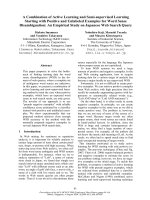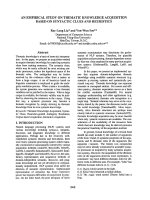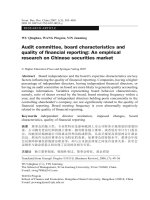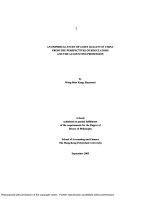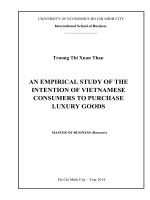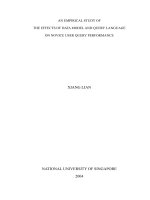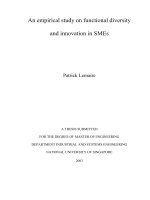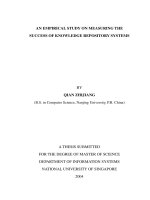An empirical study on macroeconomic determinants of exchange rate and stree testing application on vietnam non financial corporate sector
Bạn đang xem bản rút gọn của tài liệu. Xem và tải ngay bản đầy đủ của tài liệu tại đây (1 MB, 123 trang )
AN EMPIRICAL STUDY ON MACROECONOMIC DETERMINANTS OF
EXCHANGE RATE AND STRESS TESTING APPLICATION ON VIETNAM
NON – FINANCIAL CORPORATE SECTOR
In Partial Fulfillment of the Requirements of the Degree of
MASTER OF BUSINESS ADMINISTRATION
In Finance
By
Ms: Le Tran Nguyen Nhung
ID: MBA06022
Advisor: Dr. Ho Diep
International University - Vietnam National University HCMC
August 2014
AN EMPIRICAL STUDY ON MACROECONOMIC DETERMINANTS OF
EXCHANGE RATE AND STRESS TESTING APPLICATION ON VIETNAM
NON – FINANCIAL CORPORATE SECTOR
In Partial Fulfillment of the Requirements of the Degree of
MASTER OF BUSINESS ADMINISTRATION
In Finance
by
Ms: Le Tran Nguyen Nhung
ID: MBA06022
International University - Vietnam National University HCMC
August 2014
Under the guidance and approval of the committee, and approved by all its members,
this thesis has been accepted in partial fulfillment of the requirements for the degree.
Approved:
---------------------------------------------Chairperson
--------------------------------------------Committee member
---------------------------------------------Committee member
--------------------------------------------Committee member
---------------------------------------------Committee member
--------------------------------------------Committee member
Acknowledge
To complete this thesis, I have been benefited from the following people.
Firstly, I would like to express my deepest gratefulness to my advisor, Dr. Ho
Diep, for choosing me, giving many dedicated and enthusiastic instructions and
offering me good opportunity to develop myself during the six – month period of my
research. I also send my sincere gratitude to the professors and lecturers who teach me
valuable knowledge during the MBA course.
Secondly, I would like to present my special thanks to Mr. Vinh, Mr. Linh and
Ms. Ai from Vietcombank Fund Management (VCBF) for spending their time to
participate in many discussions with Dr. Diep and me and helps me gain a great deal of
useful information and innovative ideas.
Finally, to my family and best friends, thank you for your endless love and
constant support which inspires me to overcome any difficulties and discouragement to
achieve my MBA degree.
Le Tran Nguyen Nhung
- i-
Plagiaris m State ments
I would like to declare that, apart from the acknowledged references, this thesis
either does not use language, ideas, or other original material from anyone; or has not
been previously submitted to any other educational and research programs or
institutions. I fully understand that any writings in this thesis contradicted to the above
statement will automatically lead to the rejection from the MBA program at the
International University – Vietnam National University Hochiminh City.
- ii -
Copyright Statement
This copy of the thesis has been supplied on condition that anyone who consults
it is understood to recognize that its copyright rests with its author and that no quotation
from the thesis and no information derived from it may be published without the
author’s prior consent.
© Le Tran Nguyen Nhung/ MBA06022/ 2014
- iii -
Table of Contents
1. Introduction ............................................................................................................................ 1
1.1. Background ...................................................................................................................... 1
1.2. Research Problems ........................................................................................................... 2
1.3. Research Objectives ......................................................................................................... 5
1.4. Research Questions .......................................................................................................... 6
1.5. Research Methodology .................................................................................................... 6
1.6. Research Scope and Limitation........................................................................................ 6
1.7. Implications ..................................................................................................................... 7
1.8. Research Structure ........................................................................................................... 7
2. Lite rature Review .................................................................................................................. 9
2.1. Exchange Rate .................................................................................................................. 9
2.2. Exchange Rate Regimes ................................................................................................... 10
2.3. Approaches to Exchange Rate Determination ................................................................. 12
2.4. Determinants of Exchange Rate ....................................................................................... 16
2.5. Stress Testing Theory ....................................................................................................... 21
2.6. Value at Risk Model......................................................................................................... 26
2.7. Theoretical Framework .................................................................................................... 30
3. Overvie w of Exchange Rate in Vietnam .............................................................................. 31
3.1. Vietnam Exchange Rate Regimes .................................................................................... 31
3.2. The Development of Exchange Rate................................................................................ 34
3.3. Vietnam’s Exchange Rate Policy in Comparison with Other Asian Countries ............... 45
3.4. The Relationship between Exchange Rate and Its Determinants .................................... 49
4. Data Collection and Research Methodology........................................................................ 64
4.1. Data Collection................................................................................................................. 64
- iv -
4.2. Research Methodology .................................................................................................... 64
5. Data Analysis .......................................................................................................................... 75
5.1. Descriptive Statistics ........................................................................................................ 75
5.2. Regression Model for Exchange Rate’s Macro Determinants ......................................... 76
5.3. Macro Stress Testing for Exchange Rate Exposure ......................................................... 88
6. Conclusion and Recomme ndation ........................................................................................ 98
6.1. Conclusions ...................................................................................................................... 98
6.2. Recommendations ............................................................................................................ 102
6.3. Suggestions for Future Research...................................................................................... 104
References .................................................................................................................................... 105
- v-
List of Tables
Table 2.1: The strengths and weaknesses of VaR approaches
Table 3.1: Exchange rate regimes in Vietnam from 1989 to 2013
Table 3.2: Changes in the trading band around the interbank rate
Table 3.3: The SBV’ measures for managing exchange rate in 2012
Table 3.4: The exchange rate regime and monetary policy framework
Table 4.1: Expected signs of independent variables
Table 5.1: Data description
Table 5.2: Autocorrelation test
Table 5.3: Heteroscedasticity test
Table 5.4: ARCH test
Table 5.5: Correlation matrix
Table 5.6: Omitted variables test
Table 5.7: Redundant variables test
Table 5.8: Hausman test
Table 5.9: Regression model
Table 5.10: VaR using the variance – covariance approach
Table 5.11: VaR using the historical simulation approach
Table 5.12: VaR using Monte Carlo simulation
Table 5.13: Predicted EXR under ∆ GDP shock using historical simulation
Table 5.14: VaR under ∆ GDP shock
Table 5.15: Predicted EXR under ∆ CUR shock using historical simulation
Table 5.16: VaR under ∆ CUR shock
Table 5.17: Predicted EXR using historical simulation
Table 5.18: VaR under ∆ GDP and ∆ CUR shock together
- vi -
List of Figures
Figure 2.1: Stress testing and scenario
Figure 2.2: Framework for stress testing of individual portfolios
Figure 2.3: VaR at 95% confidence level
Figure 2.4: Theoretical framework
Figure 3.1: Official VND/USD rate, 1989 – 2013
Figure 3.2: Monthly fluctuation of VND/USD, 2008 – 2013
Figure 3.3: The volatility of the exchange rate in 2012
Figure 3.4: Nominal exchange rate index of several Asian currencies against USD
Figure 3.5: The relationship between exchange rate and GDP growth rate
Figure 3.6: The relationship between exchange rate and inflation rate
Figure 3.7: The relationship between exchange rate and interest rate
Figure 3.8: The relationship between exchange rate and current account
Figure 3.9: The relationship between exchange rate and FDI
Figure 3.10: The relationship between exchange rate and foreign exchange reserves
Figure 3.11: The relationship between VND/USD and VND/EUR, VND/JPY
Figure 5.1: Normality test
Figure 5.2: Stability test
- vii -
Abstract
Due to the fact that the exchange rate fluctuation can affect business performance
but Vietnamese firms have not paid much attention to gauging or managing their foreign
exchange exposure, this research examines the relationship between the exchange rate and
its macroeconomic determinants, and then develops a framework to conduct macro stress
testing by combining modern techniques such as Monte Carlo simulation and Value-atRisk (VaR) approaches to predict the level of the exchange rate variation as well as the
expected losses that companies could suffer. This provides Vietnamese companies with a
systematic way to calculate, and to reserve risk capital for their currency exposures.
This thesis proceeded by showing that the exchange rate in Vietnam is negatively
impacted by the GDP growth rate and current account balance, and positively influenced
by the exchange rate (t-1) lagged, where t is time. Based on the resultant regression model,
VaRs of the exchange rate variation and the expected loss are computed by using three
different approaches, (i) variance – covariance matrix, (ii) historical simulation and (iii)
Monte Carlo simulation; in which the Monte Carlo gives the highest and most
conservative loss that companies should reserve for. Macro stress testing is applied to
create adverse scenarios and VaR is re-calculated in the stressed market conditions. In this
study, we used a hypothetical case of a Vietnamese company with a short position of USD
1 million (the methodology can be easily adapted to any Vietnamese enterprise), under the
more conservative Monte Carlo simulation, the minimum capital reserve for the
Vietnamese company to cover the abnormal stressed loss for the next quarter and at 99%
confidence is about VND 680 million (or approximately USD 31,000).
Keywords: Exchange rate, macroeconomic determinants, stress testing, value-at-risk,
capital adequacy.
- viii -
- ix -
CHAPTER 1
INTRODUCTION
This chapter provides an overview of the study by starting with the background and
the motivation to conduct this kind of research in Vietnam. After that, the research
objectives, questions, methodology, scope and limitation are specified together with
its significance. Finally, the general framework of the study is proposed at the end of
this chapter.
1.1. Background
Exchange rate is a key element of a country and is managed under each
country’s particular context at a specific period. Exchange rate policy is always
considered as one of the crucial monetary policies, and has unpredictable effect on
other different macroeconomic goals. For example, in an open economy, real
exchange rate affects relative prices between domestic goods and importing products.
The changes in prices will lead to the changes in product demand, and then affect the
country’s inflation. Foreign exchange is also one of the most important indicators of a
country’s state of economy along with budget deficit, trade deficit, inflation, and
interest rate, etc. (Atif et al., 2012). It affects significantly level of investment and
trade activities in the economy, which are critical factors for every country. Therefore,
exchange rate is among the most observed, analyzed, and governmentally controlled
economic variables (Van Bergen, 2010).
Since Vietnam is in the process of integrating its economy into the global
economic activities, the foreign exchange will also be suffered the impact from many
factors in both positive and negative ways. For example, increasing interest rate can
attract more capital from abroad, which in turn will appreciate the Vietnam Dong
-1-
(VND) due to the higher interests paid to VND deposits. However, because of higher
cost of investment capital and debt, the increase in interest rate quite often depresses
the stock market and the growth prospective of the economy, which makes the
currency depreciated. Therefore, it is very challenging to evaluate and analyze the
influence of macroeconomic factors on the exchange rate’s fluctuation that policy
makers really care about. Due to the complicated and diversity of implementing the
exchange rate policy, this becomes a problem which is discussed frequently in
Vietnam, especially since the uncertainty of the macro economy in 2008. Managing
the exchange rate risk needs to be done suitably in order to control the inflation,
stabilize the economy, stimulate export and improve trade balance, which creates
good business environment for domestic as well as foreign enterprises.
1.2. Research Proble ms
The exchange rate in Vietnam has seen significantly volatility in recent years,
especially since the financial crisis in 2008. According to UNDP (2013), from 2007 to
the first quarter of 2008, the supply of USD had increased considerably, which
enriched the foreign exchange reserves of Vietnam and reduced the exchange rate.
However, due to high inflation and the global economic recession, the exchange rate
went up significantly during the last two quarter of 2008. The official exchange rate
VND/USD increased 5.6% at the end of 2009 compared to the same period in 2008.
The unofficial market of VND/USD continued to increase to such a degree that the
State Bank of Vietnam (SBV) had to devaluate VND of 3.3% in 2010. Moreover,
SBV announced the highest amount of VND devaluation of 9.3% after a long time
holding its value at the beginning of 2011. At the same time, it imposed the ceiling
interest rate for foreign currency deposit, and tightened the operations on the
unofficial market and the gold market. Due to the tightening operations, from 2012 to
-2-
2013, the foreign exchange rate became more stable than previous years, with a fixed
fluctuation band of 1% as SBV’s commitment.
The exchange rate fluctuations can certainly cause a great impact on firm value,
especially firms with foreign operations, foreign revenues or foreign denominated
debt(s), because the movement in exchange rate may affect a company’s future cash
flows, revenues, risk management and investment projects. Many studies have
examined the relationship between exchange rate volatility and firm value in different
markets in the world. For example, Choi and Prasad (1995) find that the stock returns
of US firms are significantly influenced by exchange rate movements. It also exists a
relationship between exchange rate and stock prices in India, Korea, and Pakistan in
either the short-run or the long-run (Abdalla and Murinde, 1997).
In Vietnam, there is very little research, which can fully describe the foreign
exchange exposure of Vietnamese companies. For instance, Huynh and Nguyen (2013)
collected monthly data from 2007 to 2012 to study the relationship between exchange
rate, interest rate and stock prices. Although there were little statistically significant in
correlation, the result still indicates that stock prices are negatively impacted by the
exchange rate volatility. However, the influence of the exchange rate movement o n
the Vietnamese firms is not remarkable. During a long period of time, although
Vietnam had registered a regime of managed floating exchange rate to the
International Montary Fund (IMF), in fact, it pursued pegged exchange rate regime
with narrow fluctuation band (Nguyen Thi Thu Hang et al., 2010). Therefore, most of
the domestic companies do not pay much attention to the exchange rate risk as well as
its hedging methods. In case of strong volatility of the exchange rate, the firms with
borrowings in USD but their revenue in VND tend to be more dangerous than the
other ones due to their responsibility for paying debts.
-3-
Nowadays, global economic integration puts pressure on all countries to change
their exchange rate policies so that their currencies can be flexibly converted in either
trade activities or investment. Since Vietnam has already joined in the World Trade
Organisation (WTO) for several years, it has to accept a more flexible exchange rate
regime, which means more unstability. Moreover, the larger the amount of portfolio
investment capital pouring into the domestic market is, the more severe the implicit
risks will be that could cause to financial crisis to the country. One more thing that
needs to be considered, according to the Circular 03/2012/TT-NHNN and Circular
29/2013/TT-NHNN of the SBV about borrowing in foreign currency, companies that
do not have any sources of foreign currency collection can only borrow in VND; and
if they pay for their imported goods, they must buy USD from banks. In addition to
high interest rate, the biggest risk that the borrowers have to face is the fluctuation of
the exchange rate, especially when USD appreciates. To be specific, the firms are
forced to pay the principal and the interest in VND plus the difference caused by the
higher exchange rate at the payment time compared to the one at the time of signing
contract.
If the exchange rate is guaranteed to be fluctuated withtin a trading band by the
central bank as Vietnam has been implementing, the firms might become subjective
and dependent on the government, which are also exposed to devaluation risks, and
then do not use any risk hedging instruments. As a result, if there are any economic
shocks happened in the market, these companies would likely be panic and overreact
since they do not know exactly how to deal with those circumstances. In other words,
there is a chance that Vietnam would change into the more flexible exchange rate
regime, probably with wider trading band; or loosening the restrictions on borrowing
in a foreign currency. At that time, the domestic companies have to struggle with
-4-
many adverse shocks beyond their withstanding while they do not prepare for any risk
controlling strategies. Thus, they need an effective risk – estimated measures to meet
capital requirements in order to cope with the foreign exchange exposure.
Additionally, stress testing is an important risk management tool used broadly
in the worldwide financial systems. It is also required as part of banks’ internal
operating analysis model under Basel II and III requirements. However, because of its
not – too – complicated techniques, stress testing could be considered to apply to
non–financial enterprises so that they can protect themselves against severe economic
situations. Particlarly, in the age of globalisation in all aspects, although the foreign
exchange risk has either direct impact on the firm’s revenue or indirect influence
through the suppliers and customers, the awareness of market risk administration of
Vietnamese companies is still low (Vu Minh, 2013). Hence, stress testing becomes
more crucial than ever before.
In general, as high volatility and sudden changes in the exchange rate is one of
the barriers for a successful macroeconomic policy as well as the companies’ business
performance, modeling volatility is a controversial research topic that needs to be
solved. This research strives to examine the sensitivity of the exchange rate to
macroeconomic factors and develop a macro stress testing framework for the foreign
exchange exposure of Vietnam domestic enterprises.
1.3. Research Objectives
General objectives
This study is to clarify the relationship between macroeconomic variables and
the exchange rate (EXR), and then conduct stress testing using value-at-risk (VaR)
approaches for the exchange rate exposure to Vietnamese firms.
-5-
Specific objectives
To review theories and studies about EXR and describe its policy in Vietnam.
To identify the key determinants as well as analyze their significance to EXR.
To apply stress testing combined with VaR model to Vietnam corporate sector.
To make conclusions and propose recommendations for Vietnam companies
about risk management and capital adequacy.
1.4. Research Questions
Based on the above objectives, this study is designed to answer some questions:
-
What are the significant macroeconomic determinants of the exchange rate?
-
How is the exchange rate expected to fluctuate in the next quarter under VaR
approaches and macro stress testing?
-
What is the expected loss of a companny under normal conditions as well as
adverse scenarios?
1.5. Research Methodology
Both qualitative and quantitative methods are used in this research. The
qualitative measure with visual results like tables and graphs is utilized to assess
preliminarily the connection between the exchange rate and its macro indicators. Then,
the quantitative one is applied to run regression model, statistical tests and calculate
VaR in normal as well as stressed markets.
1.6. Research Scope and Limitation
This study focuses on analyzing the fluctuation and macro determinants of the
exchange rate of VND/USD from the first quarter of 2005 to the first quarter of 2014.
It assumes an foreign exchange position of a hypothetical company in order to employ
the stress testing technique and calculate VaR by using three different approaches.
-6-
In terms of the limitation, firstly, the time period of this study is rather short,
just cover 37 quarters that may not demonstrate fully the comprehensive relationship
between the exchange rate and its determinants. Secondly, the research only uses
secondary data which could contain errors when collecting and calculating. Thirdly,
since it is difficult to collect quarterly data during the study period, some variables
like government expenditure and money supply are not included in the regression
model as macroeconomic determinants of the exchange rate. Finally, for its simplicity,
this study makes a assumption about a hypothetical firm’s foreign exchange position
used to conduct stress testing. Data and results do not represent any specific company,
but the tools and methodologies can be applied to any firm for managing exchange
rate risk in Vietnam.
1.7. Implications
This research is strived to identify the key macroeconomic indicators of the
exchange rate of VND/USD. The stress testing technique is also applied to the foreign
exchange risk of the non- financial companies in Vietnam so that we can estimate the
minimum capital reserve which in turn will help them survive over the unexpected
economic shocks. A clear understanding of the capital adequacy for currency
exposure could provide a foundation for the companies to manage their reserves
efficiently. Hopefully, this study can create a suitable framework with significant
variables and assumptions, which can be made reference by future research.
1.8. Research Structure
The first chapter of Introduction has described the overview of this study about
the motivation, the main purposes, the scope and limitation, etc. The content of the
remaining chapters are presented as follows.
-7-
Chapter 2 – Literature review: This chapter discusses some relevant theories
about the exchange rate, different kinds of regimes and approaches to exchange rate
determination. Furthermore, several empirical studies of the exchange rate’s macro
determinants as well as the stress testing theories are revised.
Chapter 3 – Overview of exchange rate in Vietnam: There are four main
sections included in the chapter that are the regimes of Vietnam exchange rate over
time, the development of the exchange rate po licies and its comparison to several
Asian countries, and the qualitative measurement of the relationship between the
exchange rate and its determinants.
Chapter 4 – Data collection and research methodology: The quantitative
approaches are conducted in this chapter, including the regression model to examine
the relationship between the exchange rate and its independent variables, the steps for
VaR calculation as well as macro stress testing to estimate the exchange rate variation
and the exposure.
Chapter 5 – Data analysis: Chapter 5 illustrates the empirical results of the
regression model, the value of VaR computed by using three different approaches
including variance – covariance method, historical simulation and Monte Carlo
simulation, and the application of the macro stress testing in order to measure the
abnormal loss.
Chapter 6 – Conclusion and recommendation: This chapter summarizes the
findings of this study which meet the initial objectives and answer the three research
questions. It also makes some recommendations for Vietnam companies in building
risk management tools.
-8-
CHAPTER 2
LITERATURE REVIEW
First, in this chapter, the relevant theories on exchange rate, categories of exchange
rate regimes and approaches to exchange rate determination are discussed. Next,
several studies to detemine the macroeconomic indicators of exchange rate are
reviewed, and the stress testing theory is assessed. Finally, the theoretical framework
is built which all other parts of the study must be followed.
2.1. Exchange Rate
Exchange rate is an important macroeconomic variable, which is used as a
parameter for determining international competitiveness of any currency o f any
country (Danmola, 2013). Many scholars explain the concept of exchange rate in
different dimensions. According to Hache (1983), exchange rates are relative prices of
national currencies, and under a floating rate regime they may naturally be determined
by the interplay of supply and demand in foreign exchange markets. More simply,
Kalra (2005) considers exchange rate as a national currency’s quotatio n in respect to
foreign ones. Similarly, foreign exchange rate is described as the price of one
currency expressed in terms of another currency by Eiteman et al. (2010).
It is essential to distinguish between two kinds of exchange rate. According to
Danmola (2013), nominal exchange rate (NER) is a monetary concept which
measures the relative price of the two currencies, while real exchange rate (RER) is
regarded as real concept that measures the relative price of two tradable goods
(exports and imports) in relation to non – tradable goods (domestic trade only). In
other ways, Madura (2006) simply defines RER as the actual exchange rate adjusted
for inflation effects in the two countries concerned. More clearly, RER is clarified as
-9-
the nominal exchange rate adjusted by the ratio of the foreign price level (P*) to
domestic price level (P) in the long run as the following formula.
If changes in the exchange rate just offset the differential inflation rates, the RER
index would stay at 100. If the exchange rate strengthened more than is justified by
the differential inflation, its index would rise above 100, and then the currency is
considered “overvalued” from a competitive perspective. On the other hand, the index
value below 100 would suggest an “undervalued” currency (Eiteman et al., 2010).
Additionally, the tendency for an exchange rate to fluctuate is called foreign
exchange volatility, which implies that while a spot exchange rate is observable, the
future exchange rate for any currency will not be known ahead of time (O’Brien,
2006). Furthermore, the risk that future exchange rate uncertainty poses to companies,
which conduct international business and even those that do not, is decided by both
foreign exchange volatility and the companies’ foreign exchange exposure, which is
the sensitivity of their financial results to foreign exchange rate changes. The level
and frequency of the exchange rate volatility is influenced by a country’s exc hange
rate regime discussed in the next part.
2.2. Exchange Rate Regimes
An exchange rate regime is the way an authority manages its currency in
relation to other currencies and the foreign exchange market (Wikipedia). A country
may choose its currency regime relied on its national priorities of the economy such
as economic growth, inflation, interest rate level, trade balance, etc. Hence, the choice
between fixed and flexible exchange rates may change over time as the priorities
change. The International Monetary Fund (IMF) classifies all exchange rate regimes
- 10 -
into eight specific categories, which span the spectrum of exchange rate regimes from
rigidly fixed to independently floating (Eiteman et al., 2010, p.56-57).
1. Exchange arrangements with no separate legal tender: The currency of
another country circulates as the sole legal tender or the member belongs to a
monetary or currency union in which the same legal tender is s hared by the
members of union.
2.
Currency board arrangement: A monetary regime based on an implicit
legislative commitment to exchange domestic currency for a specified foreign
currency at a fixed exchange rate, combined with restrictions on the issuing
authority to ensure fulfillment of its legal obligation.
3. Other conventional fixed peg arrangements: The country pegs its currency
(formally or de facto) at a fixed rate to a major currency or a basket of
currencies (a composite), where the exchange rate fluctuates within a narrow
margin or at most ± 1% around a central rate.
4. Pegged exchange rates within horizontal bands: The value of the currency is
maintained within margins of fluctuation around a formal or de facto fixed peg
that are wider than most ± 1% around a central rate.
5. Crawling pegs: The currency is adjusted periodically in small amounts at a
fixed preannounced rate or in response to changes in selective quantitative
indicators.
6. Exchange rates within crawling pegs (crawling bands): The currency is
maintained within certain fluctuation margins around a central rate that is
adjusted periodically at a fixed preannounced rate or in response to changes in
selective quantitative indicators.
- 11 -
7. Managed floating with no preannounced path for the exchange rate: The
monetary authority influences the movements of the exchange rate through
active intervention in the foreign exchange market without specifying, or
precommitting to, a preannounced path for the exchange rate.
8. Independent floating: The exchange rate is market – determined, with any
foreign exchange intervention aimed at moderating the rate of change and
preventing undue fluctuations in the exchange rate, rather than establishing a
level for it.
Vietnam has officially accepted the “managed floating” regime, while it is
claimed that its exchange rate regime is actually a type of “crawling peg” (Nguyen
Tran Phuc et al., 2009; Nguyen Thi Thu Hang et al., 2010). Besides, the exchange rate
fluctuation is explained in several theoretical approaches presented in the next section.
2.3. Approaches to Exchange Rate Determination
An objective of theoretical approaches of exchange rate determination is to
provide a clear understanding of the economic mechanisms governing the actual
behavior of exchange rate in the real world and of the relationships between exchange
rate and other important economic variables (Mussa, 1984). This study just presents
three main approaches in determining the exchange rate including purchasing power
parity, balance of payment, and asset market approach.
2.3.1. Purchasing Power Parity Approach
Purchasing Power Parity (PPP) is the most widely accepted theory of exchange
rate determination. This concept has been commonly used to measure the equilibrium
values of currencies and is also a relationship which underpins other exchange rate
approaches (MacDonald, 2007). There are two kinds of PPP:
- 12 -
(1) Absolute PPP indicates that the equilibrium exchange rate is equal to the
ratio of the price levels in the two countries. The shortcomings of absolute PPP are
that not all products made by a country can be traded internationally, the existence of
transportation costs and trade barriers, and the internatio nal capital flow is also
influence on the exchange rate.
(2) Relative PPP holds that the relative change in prices between two countries
leads to the proportional change in exchange rate in a certain period of time. To be
specific, as Eiteman explains, “if the spot exchange rate between two countries starts
in equilibrium, any change in the differential rate of inflation between them tends to
be offset over the long run by an equal but opposite change in the spot exchange rate”
(Eiteman et al., 2010, p.167).
Many scholars have tested PPP and they conclude that (i) PPP performs well in
the long run but poorly in the short or medium term, and (ii) PPP holds better for
countries with high inflation rate and underdeveloped capital markets. For example, if
a country experiences inflation rate relative higher than those of its most trading
partners, its exports become less competitive with overseas products, and its imports
from abroad become more price – competitive with domestic ones. These price
changes lead to a deficit on current account that causes to the variation of exchange
rate unless it is offset by capital and financial inflows (Eiteman et al., 2010).
2.3.2. Balance of Payments Approach
The PPP approach incorporates implicitly through trade, demand and supply
factors in the determination of the exchange rate. For example, if price in a foreign
country is lower than the domestic one, then domestic demand for foreign goods will
increase, and the foreign currency will appreciate. The balance of payments (BOP)
approach can be seen as encompassing the PPP (Rauli Susmel, undated).
- 13 -
The BOP, which consists of all financial flows of a country during a given
period, is an important indicator of pressure o n a country’s foreign exchange rate.
This approach involves the supply and demand for foreign exchange as determined by
the flows of currency from international transactions. This approach affirms that the
equilibrium exchange rate is established by matching the net inflow (outflow) of
foreign exchange arising from current account activities and the net outflow (inflow)
of foreign exchange arising from financial account activities (Eiteman et al., 2010). In
other words, the flows of currency related to the BOP comprise trade in goods and
services, portfolio investment, direct investment, etc. Equilibrium exchange rate is set
when the BOP is in equilibrium.
According to this approach, a current account deficit (surplus) tends to lead to a
depreciation (appreciation) of the exchange rate. However, as foreigners might be
willing to finance the current account imbalance by lending or borrowing, which in
turn produces a capital account surplus (deficit), the exchange rate depreciation
(appreciation) might not occur in the short run (Rauli Susmel, undated). Thus, the
BOP approach only has more precise predictions in the long run because the current
account imbalance can not be financed forever. The long-run exchange rate would
move to balance the current account. Another limitation of this approach is that it just
focuses on flows of currency and capital rather than stocks of money or financial
assets (Eiteman et al., 2010). That means relative stocks of money or financial assets
has no contribution in determining exchange rate in this theory.
2.3.3. Asset Market Approach
Rather than the traditional view of the exchange rate adjusting to equilibrate
international trade in the BOP, an asset market model emphasizes on financial – asset
markets. This approach states that the exchange rate is determined by the supply and
- 14 -

